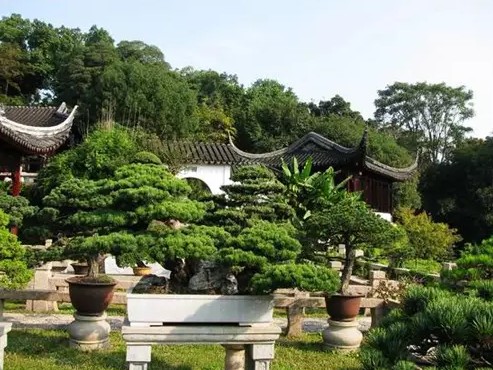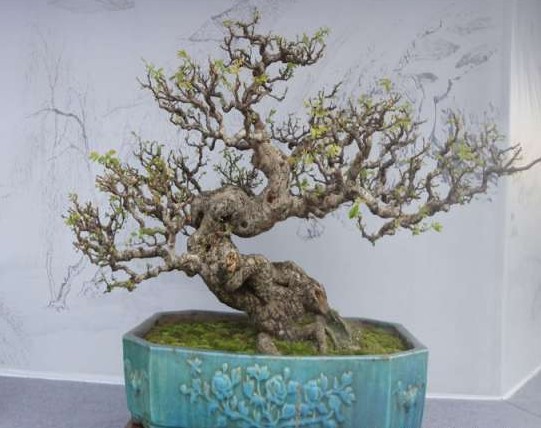The unique styling structure of Su-style bonsai
Suzhou is located on the shore of Taihu Lake, with beautiful mountains and rivers, beautiful scenery, humid climate and abundant rainfall. There is a rich variety of plants available for bonsai production. Suzhou is also rich in all kinds of rocks suitable for landscape bonsai, such as transparent and exquisite Taihu Lake Stone, Kunshan Baibai, Suzhou Huangshi and so on. This provides sufficient material conditions for bonsai production. Suzhou, which has been founded for 2500 years, is also an area with a gathering of humanities, prosperous culture and famous poems, books and paintings. Wei Yingwu, Bai Juyi and Liu Yuxi all made the history of Suzhou thorns in the Tang Dynasty. After the Song and Yuan dynasties, there were more poets and poets who came from or once lived in Suzhou, and they left a lot of poems and pictures to Suzhou. Bonsai is full of poetic works of art, these poems, articles, pictures, have become the source of creative ideas for bonsai artists.

The development of Su-style bonsai art is unique. The stone of Taihu Lake is exquisite and exquisite, and Jia trees are readily available by the cliff and stream. Suzhou has beautiful scenery and pleasant scenery, and there have long been many famous gardeners in history, who photographed the wild interest of mountains and forests in the garden art of the city, so the bonsai art of "only thousands of miles and shrinking dragons into inches" can be used for reference; in addition, Suzhou is a place where literati gather, and bonsai art has been nurtured by its culture and art for a long time, so it has gradually formed the regional characteristics and unique traditional style of Suzhou bonsai art.
Su-style bonsai is famous for its quaint elegance and simplicity. Qiugan old branches for decades or even hundreds of years have been cultivated in small pots, but they can not be full of feet and become normal naturally, either hanging or hanging, or overhanging, coupled with ancient pots and Soviet-style planes, it is full of ancient interest.
The layout of Su-style bonsai is meticulous, natural and natural, with few axe-chisel marks full of artistic interest. In dealing with the relationship between deficiency and reality, straightness, density, opening and closing, light and shade, the pulse is clear and ingenious.
Su-style bonsai focuses on the creation of artistic conception, which attracts people with its artistic charm of blending feelings and scenes. It absorbs the quintessence of classical garden art, synthesizes the expertise of Chinese painting techniques, expresses emotion with scenery, and uses artistic techniques such as "seeing the big from the small in the scene". The artistic effect works with emotion in the scene and outside the scene are intriguing and admiring.
Today, Su-style bonsai has successors, and its works are more colorful. It will edify people's thoughts and sentiments with the style of the new era, meet the needs of people's cultural life, and coruscate a brilliant brilliance. The majority of horticulturists are working hard to create a new style of Su-style bonsai art.
The great influence of Suzhou bonsai style is Shen Shitian, Wen Zhengming, Tang Bohu and Qiu Shizhou during the period of Chenghua and Hongzhi in Ming Dynasty, which is called "Wumen painting School" in later generations. In Suzhou, scholars of successive dynasties made bonsai, including Fan Chengda in the Song Dynasty, Wen Zhenheng in the Ming Dynasty, Hu Huanzhang in the Qing Dynasty, and Zhou Lianjuan in modern times. Mr. Zhou once said, "my bonsai is created on the one hand and modeled on the famous paintings of the ancients on the other." He has made bonsai by imitating Tang Bohu's Banana Stone Picture, Xia Zhongzhao's Bamboo interest Picture and half window Qingcui Map, and Wang Yanke's Xinpu Shou Stone Picture in the Qing Dynasty. Su-style bonsai is based on tree stump bonsai, and the materials used can be divided into two categories: one is deciduous trees and the other is evergreen trees. The main deciduous tree species are Yingchun, begonia, pomegranate, plum blossom, wisteria, etc.; those who view roots, branches and leaves are elm, triangular maple, red maple, sparrow plum, yellow poplar and so on. Evergreen trees are mainly camellia, rhododendron, tiger thorn, gardenia, southern bamboo, Chinese wolfbone, sweet-scented osmanthus, as well as black pine, five-needle pine, Luohan pine, pomelo, real cypress, juniper, bamboo, rice leaf holly and so on.
Before the founding of New China, there were many rules and regulations in Suzhou bonsai production, and each tree often had to be tied into ten pieces of "six sets, three supports and one item" before it could be called bonsai. This is to leave three side branches on each of the left and right sides of the trunk, and when it grows slowly, tie three pieces on each side, that is, "six", and then tie it into three pieces, that is, "three supports"; and finally tie the top into a piece, that is, "one top". These ten pieces are all made of brown silk into a round shape, which takes more than ten years. It is not only time-consuming, but also too artificial to lose nature.
In the late 1950s, Zhou slim Juan and veteran artists Zhu Zian, Zhang Shijin and others. It is advocated that bonsai should be based on natural beauty and oppose affectation. Before the trees sprouted at the end of early spring, they collected old tree stumps from the mountain forests in the suburbs, planted them in pots, and placed them in a sunny leeward or greenhouse to maintain a certain degree of humidity. after sprouting into branches, they would cut and tie along with them, and they would take shape in autumn. This is the rapid cultivation method they created, which was excavated, cultivated, cut and shaped in that year, and appreciated in that year. The bonsai made by this method of cultivating bonsai has different forms and is more natural and beautiful. At the same time, in the technique, it set a precedent of taking scissors as the main and tie as the auxiliary, changing the past method of using pruning as the main method and shearing as the auxiliary. This more advanced method of coarse binding and fine shearing has won the approval of experts all over the country. At that time, 22 large and medium-sized cities, including Beijing, Tianjin, Jinan, Yantai, Qingdao, Lanzhou, Xi'an, Lintong, Wuhu, Hefei, Guilin and Jingdezhen, sent horticulturists to gather in Suzhou Landscape Management Office to learn the "bonsai Rapid cultivation method".
At the sixth Chinese bonsai exhibition held in Quanzhou, Fujian Province, Su sent bonsai once again with a reputation and won a good achievement of one gold, three silver and three bronze. However, with the continuous improvement of bonsai technology, Suzhou, as one of the birthplaces, bonsai is more and more far away from the public, and the bonsai market is also low.
Time: 2019-06-04 Click:
- Prev

Su style bonsai technique needs innovation and development
At present, Su Sect's bonsai skills are inherited in a single way, and the number of inheritors is also very limited. For example, one provincial and two municipal representative inheritors only have one apprentice, and it is also unstable. Therefore, in addition to continuing to play the role of professional bonsai workers in scientific research and innovation,
- Next

National Intangible Cultural Heritage-- Yangpai Bonsai skill
Yang style bonsai is one of the five major schools of tree stump bonsai in China. It has a long history and the most distinctive features. Compared with Sichuan School, Su School, Lingnan School and Shanghai School, its ancient cutting skills are also the most complete. In June 2008, Yangpai bonsai skills were selected into the national intangible cultural heritage list.
Related
- Fuxing push coffee new agricultural production and marketing class: lack of small-scale processing plants
- Jujube rice field leisure farm deep ploughing Yilan for five years to create a space for organic food and play
- Nongyu Farm-A trial of organic papaya for brave women with advanced technology
- Four points for attention in the prevention and control of diseases and insect pests of edible fungi
- How to add nutrient solution to Edible Fungi
- Is there any good way to control edible fungus mites?
- Open Inoculation Technology of Edible Fungi
- Is there any clever way to use fertilizer for edible fungus in winter?
- What agents are used to kill the pathogens of edible fungi in the mushroom shed?
- Rapid drying of Edible Fungi

